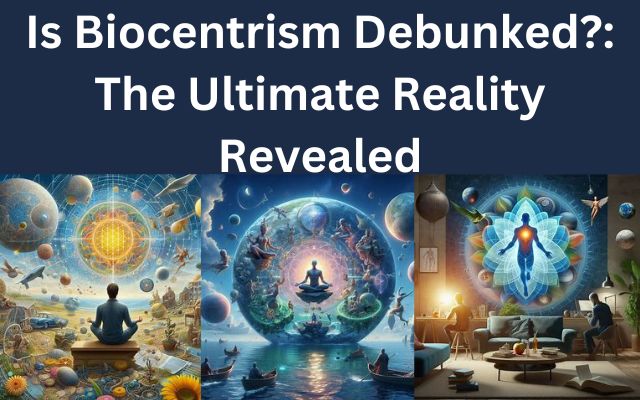Is Biocentrism Debunked?: The Ultimate Reality Revealed

“Biocentrism Debunked” – a phrase that has sparked numerous debates in the scientific and philosophical communities. Biocentrism, a theory proposed by Robert Lanza, posits that life and consciousness are fundamental to understanding the nature of our reality, and that they must be considered when interpreting the universe. However, this concept has faced its share of criticism and skepticism. This essay aims to delve into the heart of this debate, exploring the arguments for and against biocentrism, and ultimately seeking to answer the question: Is Biocentrism truly debunked? As we embark on this intellectual journey, we will strive to uncover the ultimate reality, if it indeed exists. Let’s begin.
What is Biocentrism?
Biocentrism, a term derived from the Greek words ‘bios’ meaning ‘life’, and ‘kentron’ meaning ‘center’, is an ethical viewpoint that extends inherent value to all living things. It is a perspective that understands the earth and its workings, particularly in relation to its biosphere or biodiversity. This theory stands in contrast to anthropocentrism, which centers on the value of humans.
The concept of biocentrism was introduced by Robert Lanza, who proposed this life-centric view as an alternative to our traditional anthropocentric perspective. Biocentrism merges physics and biology, focusing on the role humans and other living organisms play in shaping our reality. In this view, time and space are not distinct entities but are rather relative to the observer.
Biocentrism does not imply the idea of equality among the animal kingdom, for no such notion can be observed in nature. It is nature-based, not human-based. Advocates of biocentrism often promote the preservation of biodiversity, animal rights, and environmental protection.
The four main pillars of a biocentric outlook are:
- Humans and all other species are members of Earth’s community.
- All species are part of a system of interdependence.
- All living organisms pursue their own “good” in their own ways.
- Human beings are not inherently superior to other living things.
Biocentrism argues that we need to put limits on human population, and technology so that people can properly share the earth with other beings. It attempts to make humans a part of nature, rather than the masters of nature.
Now, we will delve into the arguments supporting biocentrism.
Arguments Supporting Biocentrism
Biocentrism, as a theory, has garnered significant attention and stirred debate within scientific and philosophical communities. The crux of biocentrism lies in the assertion that life and the universe are interconnected. According to this view, it is life that creates the universe rather than the other way around.
The proponents of biocentrism highlight several key arguments:
- Consciousness as the Core: Biocentrism offers an explanation for consciousness, a concept that many traditional physical theories have struggled to define. By placing consciousness at the heart of its framework, biocentrism provides a rationale for our self-awareness.
- Perception and Existence: The theory emphasizes the role of perception in shaping our universe. It suggests that the precise conditions of our universe, which seem perfectly tailored for life, can be understood when one recognizes that life and consciousness are central to existence.
- Interconnectedness and Complexity: Proponents argue that by recognizing the interconnectedness and complexity of all species and ecosystems, biocentrism promotes moral and ethical considerations of various life forms.
- Sustainable Practices: Biocentrism advocates for sustainable practices such as reducing consumption levels, restoring ecosystems, and taking into account consequences that affect future generations.
Despite these supporting arguments, biocentrism has faced controversies and debates within both the scientific and philosophical communities. Critics argue that while interesting, the theory falls short in providing a substantial explanation for the observed phenomena in the universe.
Arguments Against Biocentrism
While biocentrism has its proponents, it also faces significant criticism and skepticism. Critics argue that while the theory is intriguing, it lacks empirical evidence and fails to provide a comprehensive explanation for the observed phenomena in the universe.
- Lack of Empirical Evidence: Critics argue that biocentrism is more of a philosophical perspective than a scientific theory. They contend that it lacks empirical evidence and cannot be tested or falsified, which are key criteria for any scientific theory.
- Anthropocentrism: Some critics argue that biocentrism is still anthropocentric because it is a human-constructed theory that places human consciousness at the center of the universe. They argue that this contradicts the very premise of biocentrism, which seeks to decenter humans.
- Determinism: Critics also argue that biocentrism could lead to a deterministic view of life, where every event or action is determined by previous ones. This could undermine the concept of free will and moral responsibility.
- Relativism: Some critics worry that biocentrism could lead to moral relativism, where there are no absolute moral truths. If all life forms are equally valuable, it could be argued that there are no grounds for making moral judgments.
- Practicality: Critics also question the practicality of biocentrism. They argue that it is unrealistic to expect humans to consider all life forms equally, especially when it comes to issues like public health and food production.
Despite these criticisms, biocentrism continues to be a topic of discussion and debate in various fields, including philosophy, biology, and environmental ethics.
Case Studies and Examples
Biocentrism, as a theory, is not just a philosophical concept but has practical implications and applications in our daily lives. Here are some examples that illustrate the principles of biocentrism:
- Vegetarianism and Veganism: Many people choose vegetarianism or veganism because they believe in the inherent value of all life forms. They argue that animals should not be used for human consumption, reflecting a biocentric perspective.
- Anti-deforestation: Biocentrists oppose deforestation because it harms trees, which they view as valuable life forms. This contrasts with an anthropocentric perspective, which might oppose deforestation primarily because of its impact on humans.
- Opposing Fur Trade: The fur trade is often criticized for its cruelty towards animals. Biocentrists oppose the fur trade because it harms animals, demonstrating a commitment to the equal treatment of all species.
- Animal Rights: Advocates for animal rights argue for fundamental rights for animals based on their inherent value, independent of their utility for humans. This reflects a biocentric perspective, which values all life forms equally.
- Hunting and Poaching Prohibition: Attitudes towards hunting and poaching are shifting, with more areas enforcing prohibitions to conserve natural life. This trend reflects a growing recognition of the value of all life forms, a key principle of biocentrism.
These examples illustrate how biocentrism can influence our attitudes and behaviors towards other life forms. They show that biocentrism is not just a theoretical concept, but a perspective that can guide our actions and decisions in a way that respects and values all life.
FAQ
1. What is the theory of biocentrism?
Biocentrism is an ethical perspective that holds that all life deserves equal moral consideration or has equal moral standing. It argues that the only nonarbitrary ground for assigning moral standing is life itself, thus extending the boundary of moral standing about as far as it can go. All living beings, simply by virtue of being alive, have moral standing and deserve moral consideration.
2. What is biocentrism’s opinion?
Biocentrism extends inherent value to all living things. It is an understanding of how the earth works, particularly as it relates to its biosphere or biodiversity. Biocentrism places all life at the center of its value system. It believes that nature does not exist simply to be used or consumed by humans, but that humans are simply one species amongst many.
3. How does biocentrism explain death?
Biocentrism does not believe death is linear, so dying does not mean your life ends. Instead, biocentrism mentions life as an infinite cycle. So, when you die, you are transported into another world, followed by rebirth. It also touches upon the concept of evolution.
4. Who proposed biocentrism?
Biocentrism is most commonly associated with the work of Paul W. Taylor, especially his book Respect for Nature: A Theory of Environmental Ethics (1986). The idea of biocentrism was also introduced by scientist Robert Lanza.
5. What is the second principle of biocentrism?
The second principle of biocentrism states that our external and internal perceptions are inextricably intertwined. They are different sides of the same coin and cannot be divorced from one another.
6. What are 3 examples of biocentrism?
Three examples of biocentrism include:
- Vegetarianism and Veganism: Animals are not deemed appropriate for human consumption by vegetarians and vegans.
- Animal Rights: Animal rights advocates strive for fundamental rights for animals on the basis of their inherent value which is seen independent of their utility for humans.
- Anti-deforestation: When wanting to fight deforestation comes forth from an effort to avoid harming trees, it subscribes to the biocentric perspective.
7. Why do we study biocentrism?
We study biocentrism to gain a more accurate understanding of the world that considers it biologically centered. Biocentrism helps us understand that life creates the universe, instead of the other way around. Understanding this more fully yields answers to several long-held puzzles.
8. What is an example of biocentrism in real life?
One real-life example of biocentrism is the practice of vegetarianism or veganism. From a biocentric viewpoint, animals are not deemed appropriate for human consumption because all living things are valued equally.
9. What is the difference between biocentrism and anthropocentrism?
Biocentrism is the belief that all living things possess intrinsic value and should be given equal consideration in decision making. On the other hand, anthropocentrism is the belief that humans are the most important beings on Earth, and all other life forms should be viewed in relation to humanity’s needs and interests.
Conclusion: Biocentrism Debunked
The debate on biocentrism is far from settled. While it offers a compelling perspective that challenges our traditional understanding of the universe, it also raises many questions and criticisms. The theory’s emphasis on consciousness and life as fundamental aspects of reality is both its strength and its point of contention.
Biocentrism posits that space and time do not exist independently of us, but are rather tools of our consciousness. This perspective has profound implications for how we understand our place in the universe and our relationship with other life forms.
However, whether biocentrism can be definitively proven or debunked remains to be seen. As our understanding of the universe continues to evolve, so too will our theories and interpretations. For now, biocentrism serves as a thought-provoking theory that invites us to reconsider our assumptions about life, consciousness, and reality.



![[Free*Download] ” Beau Is Afraid ” (2023) YTS Torrent – Download Yify Movies Available Now - 14 Beau Is Afraid](https://techmodena.com/wp-content/uploads/2023/11/Beau-Is-Afraid-390x220.jpg)


